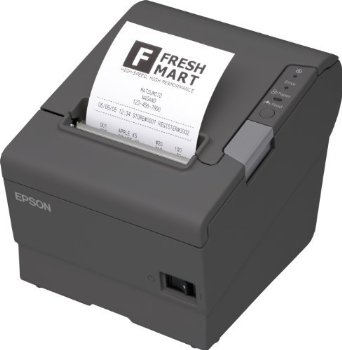Advantages of Thermal Receipt Printing
 By far, the largest single contributor to POS system operating costs is the receipt printer. It is the only part of the POS system that requires supply items and it also requires more attention than any other POS peripherals. In the new era of POS system open architecture, retailers have the chance to select from many choices, a printer that provides them with the least “trouble†and operating expense. A shift in printing technologies, which has just gotten underway in the POS arena, is beginning to provide retailers with reduced operating costs.
By far, the largest single contributor to POS system operating costs is the receipt printer. It is the only part of the POS system that requires supply items and it also requires more attention than any other POS peripherals. In the new era of POS system open architecture, retailers have the chance to select from many choices, a printer that provides them with the least “trouble†and operating expense. A shift in printing technologies, which has just gotten underway in the POS arena, is beginning to provide retailers with reduced operating costs.
Thermal printing is fast replacing impact printing in many key retail sectors. By its very nature, impact printing wears out parts faster and requires more frequent maintenance. Impact printers also require more attention because they have two supply items; ribbon and paper. Loading paper is complicated by the fact that the paper must be threaded under the ribbon. Nearly everyone has experienced the annoyance of waiting in line while the check out clerk goes looking for the resident paper/ribbon loading guru. With thermal receipt printing, their are no impact parts to deal with.
Originally, thermal printers were selected for POS applications where use of impact printers was not possible. The best example of this is the credit card receipt printers embedded in gasoline pumps. Thermal printers could be designed to withstand any foreseen weather conditions. Thermal POS printers then began to gain acceptance in less hostile environments such as grocery stores, restaurants, and theaters on the basis of higher printing speeds and better print quality. Replacement of impact printers in these latter applications has taken place even though thermally coated paper is slightly more expensive.
- Cost of Paper -Â A good quality grade of thermal paper for most POS applications will average about three times the cost of plain paper. For example, based on similar volume purchases, a plain roll of receipt paper that now costs $.40 per roll will cost $1.20Â for thermal.
- Paper Roll Length -Â Thermal paper is slightly thinner than plain bond paper so more feet per roll can be added. This means more receipts can be printed per roll for thermal than impact. More receipts per roll means less paper replacement resulting in less labor costs and downtime.
- Clean Receipt - With the ability to scan/enter items as usual but rather than printing line by line, all items are buffered for printing at the end of the total transaction. The buffered items can then be grouped according to alphabetical order and exact like items, no matter when they are scanned, can be grouped together. There are many different ways items can be grouped. For example, grouping like items will eliminate having to print two lines on the receipt. Additionally, the ability to net out all voided items so that they do not appear on the receipt tape can also be accomplished thereby saving paper. Test show paper savings gained using clean receipt can exceed 33% is some retail environments. Clean receipt has only been made recently possible by the huge increase in thermal printing speed.
- Time to change paper roll - Thermal printers incorporate an easy drop and load paper feature. This saves cashiers a tremendous amount of time over the older, more tedious paper loading requirements of impact printers. Internal testing has shown that the time to change paper can be reduced from a few minutes to less than thirty seconds. Not only does this produce hard labor savings but it also means less down time, quicker checkouts and reduced training costs.
- Excess stock handling fees - Another direct labor saving is the reduction in stock handling fees. Paper and ribbon supplies will last longer resulting in less handling. Additionally, the ribbon inventory requirement will be much less.
- Journal tape - The purchase of a thermal printer facilitates the immediate implementation of Electronic Journaling (EJ). The by-product of EJ is that the Journal station is removed thereby eliminating the cost of the second roll of paper. This is now captured electronically. Additionally, the labor cost of removing, marking and physically storing this paper roll is eliminated as well as the high cost of storage space. Instead, all data is now captured and stored on either high capacity ZIP or hard drives. This also allows for the ability to easily query and retrieve old transaction data rather than going through boxes of journal tapes.
- Ribbon Cost - Total ribbon usage will drop dramatically when installing thermal printers. Since  all receipts are now being printed using thermal technology, the ribbons are now  only used for check and document printing. The entire cost of ribbons used for receipt printing has been completely eliminated.
- Time to change ribbon - The time to change ribbons will be dramatically reduced. Since ribbons will last much longer, they will be changed much less. This will result in direct labor savings. It will also reduce the amount of down time per lane as a result of having to change those ribbons.
- Faster transaction time - The sheer speed of the thermal printers will allow for faster transaction time. In essence, this should result in the ability to process customers faster, especially during peak periods such as holidays. This should result in less labor costs and happier customers.
- Less Maintenance Costs - Thermal printer mechanisms have less moving parts so they will inherently last much longer and require less maintenance. This can be capitalized upon by either re-negotiating service costs or by implementing a different method of service such as depot maintenance. Depot can be considered a much more attractive service option with thermal printers because of their longevity.
For assistance finding the right receipt printer for your needs, contact us at Barcodes Inc.




